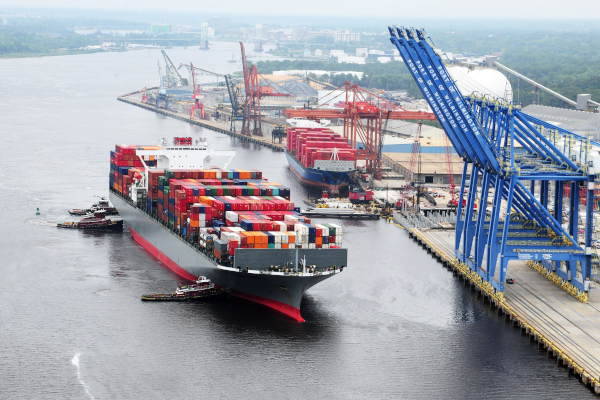The Biden administration announced Friday that it is investing more than $653 million to fund 41 port improvement projects across the nation under the Port Infrastructure Development Program (PIDP). This funding will help small- to medium-sized ports across the nation make necessary updates to improve the reliability and resiliency of the global supply chain.
The Northwest Seaport Alliance (NWSA) in Tacoma, Washington, was among those selected to receive $54 million in grant funding. The alliance plans to use the funding to support the expansion of Husky Terminal in their South Harbor with the goal of increasing the NWSA gateway’s global competitiveness and regional job opportunities.
“By densifying the terminal and expanding its refrigerated cargo capacity, we will be able to improve service for importers and help agricultural exporters move more cargo to international markets,” said Deanna Keller, Port of Tacoma commission president and co-chair of NWSA.
The terminal expansion will also support the alliance’s commitment to zero maritime emissions by 2050 or earlier, as outlined in the Northwest Ports Clean Air Strategy (NWPCAS).
“These improvements will increase the efficiency of cargo operations, reduce truck turn times, and shorten vessel stays while at berth, all of which reduce carbon emissions that impact near-port residents in our South Harbor,” said Sam Cho, Port of Seattle commission president and co-chair of the NWSA.
The Carolina State Ports Authority in Wilmington, North Carolina, was also selected to receive nearly $11 million in grant funding, with the goal of supporting the relocation and optimization of Wilmington’s North Gate. The project, which will move the North Gate port entrance to the designated truck route and away from neighborhood streets, will eliminate truck delays and congestion at a very active railroad crossing and bring the port entrance closer to the national highway network.
“This project will greatly improve the port-user experience and the movement of goods for existing general cargo customers,” said Brian E. Clark, executive director, North Carolina State Ports Authority. “The new port entrance will also allow our team to accommodate projected volume growth while laying a foundation for future expansion.
This announcement is part of the largest dedicated funding for ports and waterways in history, including nearly $17 billion through the Bipartisan Infrastructure Law. The administration hopes the funding will strengthen supply chain reliability; create workforce development opportunities; speed up the movement of goods; and improve the safety, reliability and resilience of ports.
“Everything from the food we eat to the cars we drive to the lumber and steel used to build our homes passes through America’s ports, making them some of the most critical links in our nation’s supply chain,” said U.S. Secretary of Transportation Pete Buttigieg. “These investments will help expand capacity and speed up the movement of goods through our ports, contributing to cleaner air and more good paying jobs as we go.”
You can view the full list of grant awards by state or territory here.
SC
MR


More Global Trade
- Made in Mexico, manufactured by China
- Retail sales see gains in October, reports Commerce and NRF
- Geopolitical readiness in supply chains: Strategic challenges for leaders
- Tariffs, taxes and trade: The impact of Trump’s reelection on the supply chain
- Aggregators sitting on the throne of Africa’s e-commerce supply chains: What lessons can we learn?
- Cross-border transport 2024: Navigating the surge
- More Global Trade
Latest Podcast

 Explore
Explore
Topics
Procurement & Sourcing News
- Made in Mexico, manufactured by China
- Retail sales see gains in October, reports Commerce and NRF
- Geopolitical readiness in supply chains: Strategic challenges for leaders
- With capacity to spare, logistics real estate demand remains subdued
- Tariffs, taxes and trade: The impact of Trump’s reelection on the supply chain
- How to improve demand forecasts for new product families
- More Procurement & Sourcing
Latest Procurement & Sourcing Resources

Subscribe

Supply Chain Management Review delivers the best industry content.

Editors’ Picks




